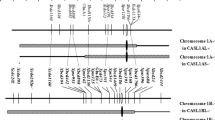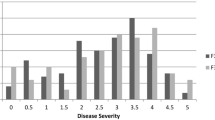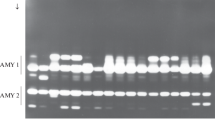Abstract
A chickpea F2 population of 593 plants derived from the intraspecific cross ILC3279 × WR315 was genotyped for markers closely linked to quantitative trait loci (QTLs) for ascochyta blight resistance (QTLAR1 and QTLAR2 located on linkage group 4 and QTLAR3 on linkage group 2). All the markers located on linkage group 4 exhibited strongly distorted segregation with respect to the expected Mendelian inheritance, towards the male parental line. This skewed segregation was also observed in a second F2 population of 50 plants derived from the same cross, confirming the presence of a region of distorted segregation on this linkage group and its heritability. The most skewed markers were SC-Y17 and TA72, which were tightly linked to each other, indicating that they may both be closely associated with the genetic factor responsible for segregation distortion in chickpea. To attempt to explain the non-Mendelian segregation, by identifying factors to which it could be attributed, three different chi-square tests were carried out to test different hypotheses using the data obtained from examining co-dominant markers associated with segregation distortion. According to our results, the distorted segregation could be caused by gametophytic factors that affect either male or female gametes. Pollen fertility and meiosis were also analysed to determine their relationship with segregation distortion; however, these not seem to be inducing factors in the non-Mendelian segregation reported in this study.


Similar content being viewed by others
References
Abbo S, Molina C, Jungmann R, Grusak MA, Berkovitch Z, Reifen R, Kahl G, Winter P, Reifen R (2005) Quantitative trait loci governing carotenoid concentration and weight in seeds of chickpea (Cicer arietinum L.). Theor Appl Genet 111:185–195
Cho S, Chen W, Muehlbauer FJ (2004) Pathotype-specific genetic factors in chickpea (Cicer arietinum L.) for quantitative resistance to ascochyta blight. Theor Appl Genet 109:733–739
Cobos MJ, Rubio J, Strange RN, Moreno MT, Gil J, Millán T (2006) A new QTL for ascochyta blight resistance in an RIL population derived from an interspecific cross in chickpea. Euphytica 149:105–111
Cobos MJ, Winter P, Kharrat M, Cubero JI, Gil J, Millán T, Rubio J (2009) Genetic analysis of agronomic traits in a wide cross of chickpea. Field Crops Res 111:130–136
Collard BCY, Pang ECK, Ades PK, Taylor PWJ (2003) Preliminary investigation of QTL associated with seedling resistance to ascochyta blight from Cicer echinospermum, a wild relative of chickpea. Theor Appl Genet 107:719–729
Flandez-Galvez H, Ades PK, Ford R, Pang ECK, Taylor PWJ (2003) QTL analysis for ascochyta blight resistance in an intraspecific population of chickpea (Cicer arietinum L.). Theor Appl Genet 107:1257–1265
Iruela M, Rubio J, Barro F, Cubero JI, Millán T, Gil J (2006) Detection of two quantitative trait loci for resistance to ascochyta blight in an intra-specific cross of chickpea (Cicer arietinum L.): development of SCAR markers associated with resistance. Theor Appl Genet 112:278–287
Iruela M, Castro P, Rubio J, Cubero JI, Jacinto C, Millán T, Gil J (2007) Validation of a QTL for resistance to ascochyta blight linked to resistance to fusarium wilt race 5 in chickpea (Cicer arietinum L.). Eur J Plant Pathol 119:29–37
Kaló P, Endre G, Zimányi L, Csanádi G (2000) Construction of an improved linkage map of diploid alfalfa (Medicago sativa). Theor Appl Genet 100:641–657
Kazan K, Muehlbauer FJ, Weeden NF, Ladizinsky G (1993) Inheritance and linkage relationships of morphological and isozyme loci in chickpea (Cicer arietinum L.). Theor Appl Genet 86:417–426
Kosambi DD (1944) The estimation of map distance from recombination values. Annu Eugen 12:172–175
Lambrides CJ, Godwin ID, Lawn RJ, Imrie BC (2004) Segregation distortion for seed testa color in mungbean (Vigna radiata L. Wilcek). J Hered 95(6):532–535
Li W, Lin Z, Zhang X (2007) A novel segregation distortion in intraspecific population of asian cotton (Gossypium arboretum L.) detected by molecular markers. J Genet Genomics 34(7):634–640
Lorieux M, Perrier X, Goffinet B, Lanuad C, Gonzalez de Leon D (1995) Maximum-likelihood models for mapping genetic markers showing segregation distortion. 2. F2 populations. Theor Appl Genet 90:81–89
Lu H, Romero-Severson J, Bernardo R (2002) Chromosomal regions associated with segregation distortion in maize. Theor Appl Genet 105:622–628
Mano Y, Muraki M, Fujimori M, Takamizo T, Kindiger B (2005) AFLP-SSR maps of maize × teosinate and maize × maize: comparison of map length and segregation distortion. Plant Breed 124:432–439
Millán T, Rubio J, Iruela M, Daly K, Cubero JI, Gil J (2003) Markers associated with ascochyta blight resistance in chickpea and their potential in marker-assisted selection. Field Crops Res 84:373–384
Perfectti F, Pascual L (1996) Segregation distortion of isozyme loci in cherimoya (Annona cherimola Mill). Theor Appl Genet 93:440–446
Pham JL, Glaszmann JC, Sano R, Barbier P, Ghesquiére A, Second G (1990) Isozyme markers in rice: genetic analysis and linkage relationships. Genome 33:348–359
Radhika P, Gowda SJM, Kadoo NY, Mhase LB, Jamadagni M, Sainani MN, Chandran S, Gupta VS (2007) Development of an integrated intraspecific map of chickpea (Cicer arietinum L.) using two recombinant inbred line populations. Theor Appl Genet 115:209–216
Rakshit S, Winter P, Tekeoglu M, Juarez Muñoz J, Pfaff T, Benko-Iseppon AM, Muehlbauer FJ, Kahl G (2003) DAF marker tightly linked to a major locus for ascochyta blight resistance in chickpea (Cicer arietinum L.). Euphytica 132:23–30
Santra DK, Tekeoglu M, Ratnaparkhe M, Kaiser WJ, Muehlbauer FJ (2000) Identification and mapping of QTLs conferring resistance to ascochyta blight in chickpea. Crop Sci 40:1606–1612
Sibov ST, de Souza CL, Garcia AAF et al (2003) Molecular mapping in tropical maize (Zea mays L.) using microsatellite markers. 1. Map construction and localization of loci showing distorted segregation. Hereditas 139:96–106
Song XL, Sun XZ, Zhang TZ (2006) Segregation distortion and its effect on genetic mapping in plants. J Agric Biotechnol 14(2):286–292
Taylor DR, Ingvarsson PK (2003) Common features of segregation distortion in plants and animals. Genetica 117:27–35
Tekeoglu M, Rajesh PN, Muehlbauer FJ (2002) Integration of sequence tagged microsatellite sites to the chickpea genetic map. Theor Appl Genet 105:847–854
Udupa SM, Baum M (2003) Genetic dissection of pathotype-specific resistance to ascochyta blight disease in chickpea (Cicer arietinum L.) using microsatellite markers. Theor Appl Genet 106:1196–1202
Van Ooijen JW (2006) JoinMap 4.0, software for the calculation of genetic linkage maps in experimental populations. Plant Research International, Wageningen, the Netherlands
Winter P, Pfaff T, Udupa SM, Hüttel B, Sharma PC, Sahim S, Arreguin-Espinoza R, Weigand F, Muehlbauer FJ, Kahl G (1999) Characterization and mapping of sequence-tagged microsatellite sites in the chickpea (Cicer arietinum L.) genome. Mol Gen Genet 262:90–101
Winter P, Benko-Iseppon AM, Hüttel B, Ratnaparkhe M, Tullu A, Sonnante G, Pfaff T, Tekeoglu M, Santra D, Sant VJ, Rajesh PN, Kahl G, Muehlbauer FJ (2000) A linkage map of the chickpea (Cicer arietinum L) genome based on recombinant inbred lines from a C. arietinum × C. reticulatum cross: localization of resistance gene for fusarium wilt races 4 and 5. Theor Appl Genet 101:1155–1163
Xu Y, Zhu L, Xiao J, Huang N, McCouch SR (1997) Chromosomal regions associated with segregation distortion of molecular markers in F2, backcross, doubled-haploid and recombinant inbred populations in rice (Oryza sativa L.). Mol Gen Genet 253:535–545
Yan JB, Tang H, Huang YQ, Zheng YL, Li JS (2003) Genetic analysis of segregation distortion of molecular markers in maize F2 population. Acta Genetica Sinica 10:913–918
Zhang F, Wan XQ, Pan GT (2006) Genetic analysis of segregation distortion of molecular markers in maize F2 population. Acta Agronomica Sinica 32(9):1391–1396
Zhao B, Deng QM, Zhang QJ, Li JQ, Ye SP, Liang YS, Peng Y, Li P (2006) Analysis of segregation distortion of molecular markers in F2 population of rice. Acta Genetica Sinica 33(5):449–457
Acknowledgments
This work has been supported by the project of the Spanish National Institute for Agricultural and Food Research and Technology (INIA, no. RTA2007-00030). P. Castro acknowledges grant support from INIA and the Andalusian Institute for Research and Training in Agriculture, Food and Fisheries (IFAPA, Spain).
Author information
Authors and Affiliations
Corresponding author
Additional information
An erratum to this article can be found at http://dx.doi.org/10.1007/s10681-011-0397-y
Rights and permissions
About this article
Cite this article
Castro, P., Rubio, J., Cabrera, A. et al. A segregation distortion locus located on linkage group 4 of the chickpea genetic map. Euphytica 179, 515–523 (2011). https://doi.org/10.1007/s10681-011-0356-7
Received:
Accepted:
Published:
Issue Date:
DOI: https://doi.org/10.1007/s10681-011-0356-7




